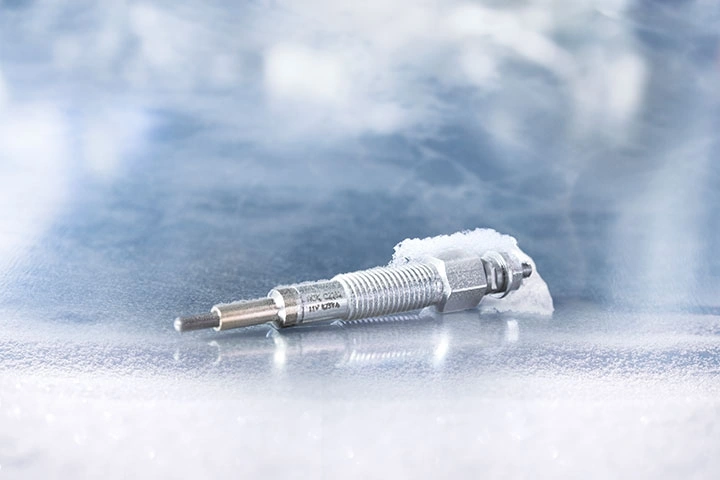Winter Glow Plugs: What every diesel driver should know

When it comes to glow plugs, there’s probably no better expert than Kai Wilschrei, Manager Technical Services Aftermarket EMEA at NGK SPARK PLUG. From the world’s number one spark plug manufacturer you’d expect nothing but the best from their glow plugs too; and you’d be right. We’ve met Kai at the company’s state-of-the-art Technical Center in Ratingen, Germany for the inside track on winter glow plugs.
He surprises us with the basics. “When you have a diesel car these days, you need to appreciate how much it relies on fully working glow plugs,” he reveals. “Most people know that glow plugs are an indispensable starting aid at low temperatures. But now they’ve also taken over extra tasks to make combustion cleaner and comply with environmental regulations. The type of glow plugs you have fitted, and how you look after them, are therefore vital to get right.”
 Ignition insight
Ignition insight
“Diesel engines use glow plugs as a kind of immersion heater - pre-heating the intake air in the combustion chamber in order to help them start – especially when the weather gets cold,” says Kai. “In normal temperatures, ambient air is drawn into the engine cylinders and then massively compressed to reach around 900 degrees Celsius. Then when the fuel is injected, it ignites spontaneously. But in winter, the cold cylinder walls, pistons and valves extract heat from the already cold intake air, preventing air compression alone from achieving the necessary combustion temperature. Extra heat is needed – and that’s where the glow plugs come into play.”
As we talk, Kai shows us some original equipment (OE) quality glow plugs from the company’s replacement ranges: Yellow Line, and for certain markets, D-Power. Glow plugs are hard to spot when fitted in the cylinder head, so not every driver knows that they look a bit like a silver pen. As soon as a current is supplied, the plugs heat up and the tip glows: hence the name. This provides the extra heat needed for stable combustion, and to reduce exhaust smoke and other unwanted emissions. Then, once the engine is running, the glow plugs either return to being idle or continue to work, depending on their type.
 The secret of pre-heating
The secret of pre-heating
The speed and efficiency of many modern glow plugs is impressive, producing a similar start to a petrol engine. However, unlike spark plugs, car manufacturers don’t set mandatory change intervals for glow plugs, even though their performance might deteriorate with time. “We strongly encourage diesel drivers to get their glow plugs checked pre-winter, even if you don’t think there is a problem. A defect glow plug might not be recognised in spring or summer, but then, out of the blue, the car won’t start in cold weather,” warns the expert.
Illustrating this, Kai shows us a two-minute NGK YouTube video on glow plug testing. This highlights that, if a vehicle’s pre-glow control light is on or flashing (and in certain models, when the MIL lamp is also on), or if there are cold-starting issues, a workshop will need to test the glow plugs and replace any defective ones. “If you want a reliable cold start all year round, don’t wait for a dashboard warning to get your glow plugs checked,” he advises.
 An environmental role
An environmental role
Kai also expands on the other reasons why glow plug faults should be tackled pre-winter. “Few drivers realise that glow plugs make a massive difference to their car’s ability to meet current emissions standards. With modern engines, plugs must be able to glow for several minutes after the engine is running (‘post-glow’), to reduce exhaust emissions. Many car manufacturers also demand glow plugs that can glow intermittently: in certain driving situations, these types become energised even when the engine has warmed up, preventing the engine from over-cooling when the car travels downhill. They also help during regeneration of the diesel particulate filter (DPF) by raising the combustion chamber temperature, which in turn increases exhaust gas temperature.”
Due to that role, a simple glow plug issue could snowball into something more costly. “If the glow plugs on a car with a DPF aren’t working properly, the DPF itself could become clogged and need to be replaced. That’s why spotting and solving defect glow plugs is vital for the protection of other parts.”
 The best types for winter
The best types for winter
With winter already here, what are Kai’s top choices for ignition reliability? “There are two main glow plug technologies: metal rod and ceramic. Both can improve cold-start performance, but ceramic ones provide extra advantages when the temperature drops,” he tells us. He warns however that although both types look quite similar, in terms of resistance and voltage they are quite different, so not interchangeable.
Metal rod (sheathed) glow plugs feature a heating coil inside a glow rod made of heat-resistant metal. Compressed magnesium oxide inside this insulates the heating coil from vibrations and provides a thermal conductor that quickly dissipates the heat outwards, raising the combustion chamber temperature and igniting the fuel.
Ceramic glow plugs are engineered to perform under even the most extreme conditions. Thanks to ceramic’s high melting point, these plugs can withstand very rapid heating to higher temperatures over extended service periods. Their excellent thermal conductivity enables diesel engines to reach a pre-heating (pre-glowing) temperature of more than 1,000 degrees Celsius in under two seconds, even in sub-zero weather. They can also sustain more than ten minutes of after-glow at up to 1,350 degrees Celsius. This reduces white and blue smoke – lowering hydrocarbon and carbon-monoxide emissions – and eliminates cold start knocking. Ceramic technology can also be made in a small size that is ideal for compact modern engines.
As we leave, Kai has a last word of advice for diesel drivers. “There are so many tasks performed by glow plugs, not only in winter. It’s worth being proactive and asking your workshop to check the plugs in your car. No-one wants to get caught out on a frosty morning!”
To watch NGK SPARK PLUG’s glow plug testing video and others, visit YouTube or NGK’s TekniWiki advice platform, www.tekniwiki.com.
 Niterra Blogs
Niterra Blogs







